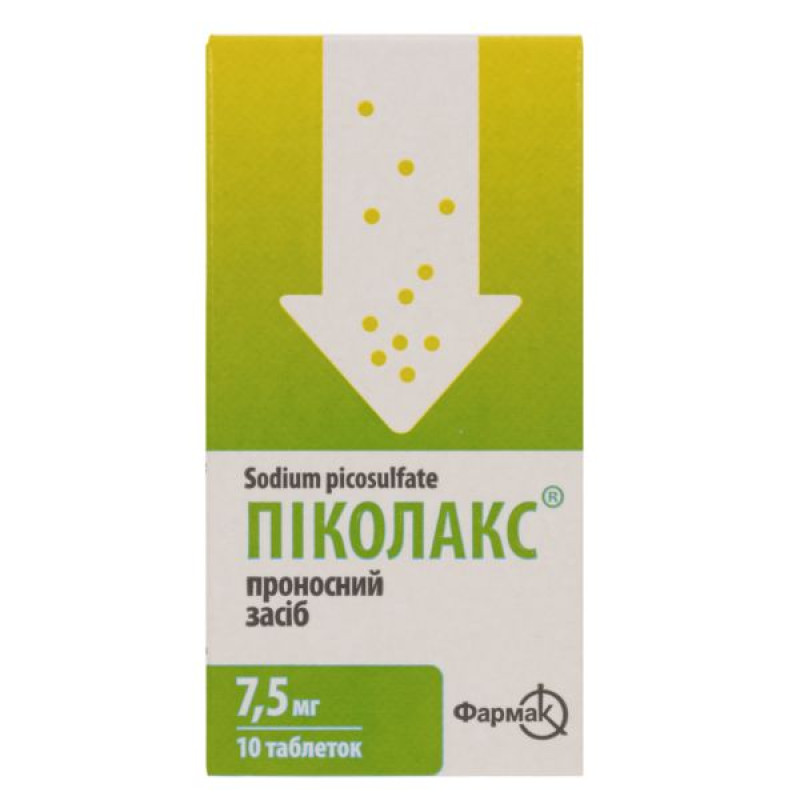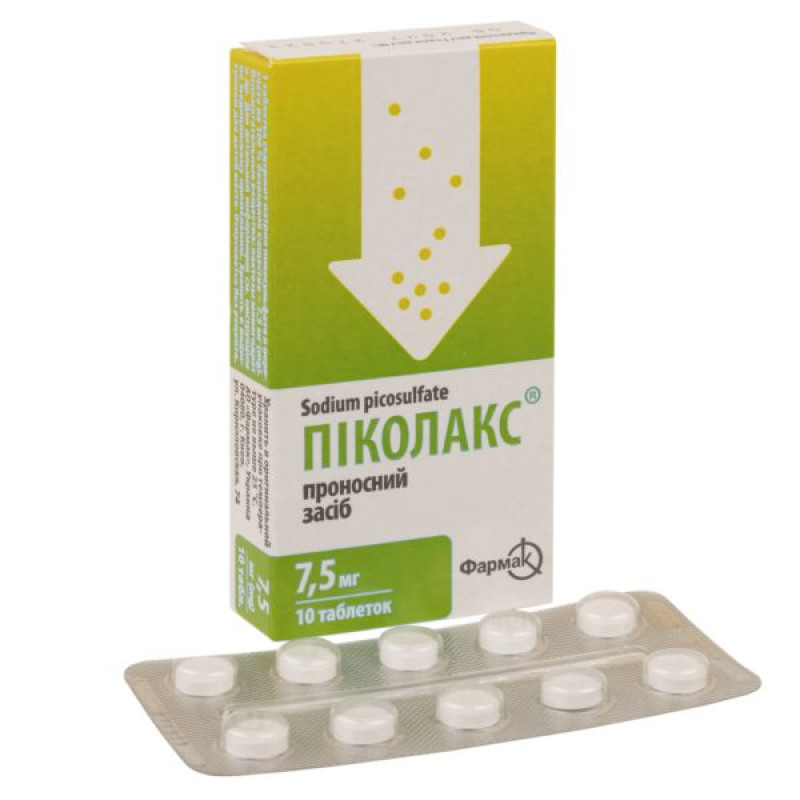Picolax tablets 7.5 mg blister No. 10

Instructions for use Picolax tablets 7.5 mg blister No. 10
Composition
active ingredient: sodium picosulfate,
1 tablet contains sodium picosulfate, calculated as 100% anhydrous substance, 5 mg or 7.5 mg;
Excipients: lactose monohydrate, corn starch, pregelatinized starch 1500, colloidal silicon dioxide, magnesium stearate.
Dosage form
Pills.
Main physicochemical properties: white or almost white tablets, flat-cylindrical, with a score and a bevel.
Pharmacotherapeutic group
Contact laxatives. ATX code A06A B08.
Pharmacological properties
Pharmacodynamics
Sodium picosulfate, the active ingredient of Picolax, is a local laxative of the triarylmethane group. Sodium picosulfate, after bacterial cleavage in the colon, stimulates its mucosa, accelerating peristalsis, and promotes the accumulation of water and electrolytes in the lumen of the colon. The result is stimulation of defecation, reduction of transit time, and softening of feces.
Pharmacokinetics
Absorption and distribution.
After oral administration, sodium picosulfate reaches the large intestine without significant absorption.
Biotransformation.
The active metabolite bis-(p-hydroxyphenyl)-pyridyl-2-methane (BHPM) is formed after bacterial cleavage in the colon.
Crossing.
Elimination
After conversion, only a small amount of BHPM is absorbed. After oral administration of 10 mg of sodium picosulfate, 10.4% of the total dose is excreted as BHPM glucuronide in the urine after 48 hours. In addition, BHPM is excreted as a glucuronide in the bile.
Relationship between pharmacokinetics and pharmacodynamics.
The onset of action of Picolax usually occurs 6-12 hours after taking the drug, depending on the release of the active metabolite (BGPM). The laxative effect of the drug does not correlate with the level of the active metabolite in the blood plasma.
Indication
Constipation or cases requiring easier defecation.
Contraindication
Hypersensitivity to the active substance, other triarylmethanes or to any of the excipients of the drug.
Intestinal obstruction.
Severe painful and/or febrile diseases of the abdominal organs (e.g. appendicitis), potentially associated with nausea and vomiting.
Acute inflammatory bowel diseases.
Acute inflammatory bowel diseases.
Severe dehydration.
Rare hereditary intolerance to any of the excipients of the drug, for example, there is a possibility of undiagnosed lactose intolerance (see section "Special instructions").
Interaction with other medicinal products and other types of interactions
Concomitant use of high doses of Picolax® and diuretics or corticosteroids may increase the risk of electrolyte imbalance, which may lead to increased sensitivity to cardiac glycosides.
Concomitant use with antibiotics may weaken the laxative effect of Picolax®.
Application features
Like other laxatives, Picolax® should not be used daily or for a long period of time without establishing the cause of constipation.
Patients suffering from chronic constipation should undergo a complete diagnosis and determine the cause of the constipation.
Prolonged use of the drug may lead to disturbances in water and electrolyte balance and hypokalemia.
Discontinuation of Picolax may result in a return of symptoms. If Picolax has been used for chronic constipation for a long time, any return of symptoms may be more pronounced.
Discontinuation of Picolax may result in a return of symptoms.
Cases of dizziness and/or syncope have been reported to occur in association with the use of sodium picosulfate. Available information suggests that these events are consistent with syncope during defecation (associated with the Valsalva maneuver) or are related to a vasovagal response to abdominal pain.
Self-reported cases of dizziness and/or syncope with the use of sodium picosulfate.
Like other laxatives, the drug should not be used daily or for a long period without establishing the cause of constipation.
The drug should be taken under medical supervision in conditions associated with impaired water and electrolyte balance (for example, severe renal impairment).
The drug contains lactose, which should be taken into account by patients with hereditary lactose intolerance.
Use during pregnancy or breastfeeding
There are no adequate studies of sodium picosulfate in pregnant women. For safety reasons, Picolax should not be used during pregnancy if possible.
Clinical data show that neither the active metabolite bis-(p-hydroxyphenyl)-pyridyl-2-methane (BHPM) nor its glucuronides are excreted in breast milk. Therefore, Picolax can be used during breastfeeding.
Studies to assess the effect on fertility have not been conducted.
Ability to influence reaction speed when driving vehicles or other mechanisms
However, patients should be warned about the possibility of developing adverse reactions such as dizziness and/or syncope due to vasovagal reactions (including abdominal spasms). In the event of abdominal spasms, the patient should avoid potentially hazardous activities such as driving or operating machinery.
Method of administration and doses
Adults: 5-10 mg once a day.
Children over 4 years of age (only as prescribed by a doctor): 2.5-5 mg once a day.
It is recommended to start with the lowest dose. The dose may be adjusted up to the maximum recommended dose for regular bowel movements. The maximum daily dose of 10 mg (for adults) or 5 mg (for children aged 4 years and above) should not be exceeded.
Picolax® should be taken at night. After using Picolax, bowel movements occur 10-12 hours later.
Picolax®.
Picolax® should not be used daily or for a long period of time without determining the cause of constipation.
Children
The drug should be used in children over 4 years of age only as prescribed by a doctor.
Overdose
Overdose may lead to loose stools (diarrhea), intestinal cramps, and clinically significant loss of fluid, potassium, and other electrolytes.
Overdose in acute defecation.
In case of acute overdose, the effects can be minimized or eliminated by inducing vomiting or gastric lavage shortly after taking Picolax. Fluid replacement and correction of electrolyte balance may be necessary. Antispasmodics may be used.
Ischemia of the colonic mucosa has been reported with the use of large doses of Picolax, significantly higher than those usually recommended for constipation.
Picolax, like other laxatives, can cause chronic diarrhea and abdominal pain, hypokalemia, secondary hyperaldosteronism, and possibly kidney stones in case of prolonged overdose. Renal tubular damage, metabolic alkalosis, and muscle weakness resulting from hypokalemia have been reported with prolonged laxative abuse.
Adverse reactions
Skin and subcutaneous tissue disorders: angioedema, toxicoderma, rash, itching.
Immune system disorders: hypersensitivity reactions.
Nervous system: dizziness, syncope. The likelihood of dizziness and syncope is associated with a vasovagal reaction (such as abdominal spasm or defecation) (see section "Special warnings and precautions for use").
Gastrointestinal: diarrhea, abdominal cramps, abdominal pain, abdominal discomfort, vomiting, nausea.
Prolonged and excessive use of the drug can lead to loss of fluid, potassium and other electrolytes. This, in turn, can lead to muscle weakness and impaired cardiac function, especially when the drug is used simultaneously with diuretics or corticosteroids.
Long shelf life of the drug.
Expiration date
4 years.
Do not use the drug after the expiration date indicated on the package.
Storage conditions
Store in original packaging at a temperature not exceeding 25 °C.
Keep out of reach.
Keep out of reach of children.
Packaging
10 tablets in a blister.
5 mg tablets: 1 blister per pack.
7.5 mg tablets: 1 or 3 blisters in a pack.
Vacation category
Without a prescription.
Producer
OJSC "Farmak".
Location of the manufacturer and its business address
Ukraine, 04080, Kyiv, Kyrylivska St., 74.
There are no reviews for this product.
There are no reviews for this product, be the first to leave your review.
No questions about this product, be the first and ask your question.








